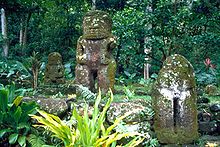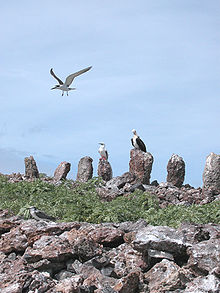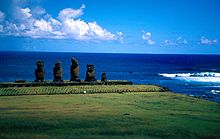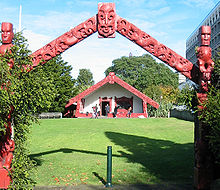Marae
A marae ( synonyms : malae, mala'e, ma'ae, meae, marai ( James Cook )) is a demarcated area reserved for ceremonial purposes in the Polynesian cultures. In Eastern Polynesia, the ceremonial site is an architectural, on some islands even a monumental temple complex. It is usually a rectangular, fenced-in place, at the end of which a stone-clad platform rises, on some islands with statues. The marae concept occurs throughout the Polynesian Triangle , from New Zealand in the west to Easter Island in the east, from Hawaii in the north to the Austral Islands in the south. Based on a common basic concept, the self-sufficient development of the Polynesian archipelago over the centuries of settlement has led to a multitude of different variants with independent forms of expression.
Origin and development
A fenced-in, holy area (Greek: Temenos ) as the religious center of human settlement can be found in almost all cultures of the world, whether in Egypt , ancient Greece , Mesopotamia , China , Southeast Asia or in Central and South America . The basic scheme follows a principle that is the same everywhere:
- On the way or on the way,
- Boundary and
- Elevation.
Nevertheless - and this should be emphasized - they are self-sufficient, completely independent parallel developments.
In Polynesia, the marae concept has a unique origin: the back support of an honor seat. The starting point of the development was the cult or meeting place of a settlement, originally nothing more than an area cleared of vegetation and leveled. The chief's seat was marked with a large, vertical stone tablet ( orthostat ) on which the tribal leader could lean. This “ throne ” was later flanked by other, usually lower, supports for the other notables . The next step in the development of the representation of the social rank was the increase of the seats by mounds of earth, which were later summarized in a common word . As a further step, a border marker (Greek: Peribolos ) was set up to demarcate the sacred area reserved for the tribal elite , for example with white marker stones or as an earth wall. Such an original form of the marae can still be found on some islands of the Tuamotu Archipelago .
The later architectural representation of the elevation as a single or even multi-level platform ( ahu ) in artistically executed masonry was merely a logical further development. Monumental examples can still be seen today in Tahiti or Hiva Oa .
The seat back was given an anthropomorphic shape on some islands and developed further into the stone statues of the Society Islands , Hawaiis, the Marquesas , Pitcairns and the Austral Islands , to finally find its culmination point (and at the same time tragic end) in the gigantic Moai of Easter Island. The principle behind this was to represent the tribal leaders and founding ancestors in an eternal guardian role even when they were not (no longer) physically present.
A ceremonial route to or from the ceremonial complex can no longer be proven archaeologically today. On Raivavae , the path that always faces the sea has been carefully paved and marked with vertical coral orthostats up to 3 m high.
Closely associated with the marae were houses built from perishable materials for ceremonial purposes, such as fare pupu (meeting house) and fare tahua (residence of the priests) on the Society Islands or ha'e toa (house of warriors), ha'e patu tiki (tattoo shop ) and ha'e ko'o'ua (old man's house) in the Marquesas.
Some plants are known to be associated with the marae complex, for example the paper mulberry tree ( Brussonetia papyrifera ), whose bark was used to make tapa bark fiber under elaborate rituals to clothe the wooden idols, from the sacred and auspicious Ti plant ( Cordyline terminalis ) or the Miro tree ( Thespesia populnea ), which donated the wood for carving the tiki . These plants can still be found today in the immediate vicinity of the historic ceremonial sites.
Intended use
The marae were endowed with high spiritual power ( mana ) and inviolability ( tapu ) and served religious purposes, but also had significance as a symbol of political power. In the Society Islands, but also on some other islands of Polynesia, it was customary to pass on the mana of a marae. If a new ceremonial platform was built, a corner stone was removed from an existing one and placed as a “cornerstone” in the new structure.
Little is known about the religious ceremonies, as the rites have only been passed on orally, if at all, and were largely inaccessible to early European visitors. Tahiti has handed down the presentation of the images of the gods, which were washed at regular intervals in elaborate ceremonies and newly clothed with tapa . Human sacrifices took place on some marae ; James Cook witnessed such a sacrificial ritual in Tahiti in 1774. The marae was also the place for social acts of the aristocracy such as council meetings, ritual celebrations, dances and recitations of traditional chants, the proclamation of war or the inauguration of a tribal chief.
The Polynesians still respect the ancient ceremonial sites today. For example, it would never occur to a Polynesian to move a stone on the marae or to leave rubbish lying around. On Rarotonga , the now democratically elected tribal leaders ( ariki ) are traditionally introduced to their office at the marae.
Specifics of the islands
Marquesas
In the Marquesas , the term me'ae is used for any sacred place in the tribe. On Nuku Hiva and Ua Pou , as on Easter Island, the term ahu is not only used for the ceremonial platform as part of the marae, but for the entire complex. The marae of the Marquesas can be divided into two classes according to their intended use: marae for the ceremonies of the tribe and burial marae. The former were integrated into the tohua , the central meeting place of the settlement, and laid out as artistically built, often stepped stone platforms. As the property of the tribal chiefs, they were used to hold the religious ceremonies that accompanied the great festivals. Food was presented here as sacrifice or tribute , and some important ceremonies also included human sacrifices. Some platforms contained pits for storing the sacrificial skulls. Even today, the grounds are often shaded by huge banyan trees , in which, according to tradition, the spirits lived.
The funeral marae were used to present the corpses of important people who, wrapped in precious tapas , were exposed to the elements until they dissolved. The remaining parts of the skeleton were ceremonially cleaned after a while and buried in special burial caves or pits.
On the platforms - at least the important marae - stood tikis , stone and probably wooden images of the deified, mythical ancestors. The largest preserved marae of the Marquesas, with monumental stone tikis up to 2.5 m high, is located in the Puamau Valley on the island of Hiva Oa .
Tonga
On Tongatapu , the main island of the Tonga Archipelago, the marae has been completely transformed into a burial site and the Ahu into a stone-clad burial mound, a development that can be traced back to around 1200 AD. There are three forms, depending on the social rank of the person buried:
- tanuanga for members of the common people, a small, low mound of earth or sand
- fa'itoka for chiefs, a tumulus made of sand or earth with an interior, carefully placed burial chamber made of stone
- langi for the Tu'i Tonga, the kings of Tonga.
The royal burial ground is near Lapaha (now the village of Mua) in the east of the island. The complex, surrounded by a moat, originally had the function of a fortress , a sheltered living space for the Tu'i Tonga, but over time it developed into the spiritual and political center of the kingdom. For the deceased rulers, monumental, often multilevel stone platforms ( langi ) were built in which the royal corpse was buried. They are rectangular and clad with huge limestone slabs up to 3 m high and 7.5 m long , which were cut from the nearby coral reef. The highlight of the development is the three-tier Paepae-'o-tele'a made entirely of stone , which was built in the 16th century for the 29th Tu'i Tonga.
The burial of the royal body took place in a stone chamber, directly within the top platform level. A mortuary made of perishable materials was built over the chamber for the funeral ceremonies.
Society Islands
On the Society Islands, a distinction has to be made between the large coastal marae that were built directly on the edge of the sea (for example the Marae Taputapuatea on the island of Raiatea ) and the inland marae (for example the Marae Arahurahu on Tahiti), which were once densely populated , steep valleys raised. The coastal marae were of national importance and often dedicated to a specific deity, the Marae Taputapuatea, for example, the god of war Oro . The inland marae were assigned to a particular tribe or clan . There were also smaller marae ( marae tupuna ) - sacred places where the ancestors of a single family were worshiped - as well as marae for certain professional groups, such as fishermen, canoe builders or wood carvers.
On the Leeward Islands ( Tahiti , Moorea , Tetiaroa ) the ceremonial square no longer consisted of a leveled and marked area, but was delimited with a massive, stone wall. Later, possibly between 1000 and 1100 AD, the space between the walls surrounding the courtyard was filled in, thus initiating the first step in the development of a stepped building. The further development consisted in the addition of further steps, the masonry of which consisted of carefully prepared, cone-shaped house stones that were layered on top of one another without mortar. The interior was filled with earth. The climax of this development was reached at the end of the 17th century in the more than 15 m high, ten-step Marae Mahaiatea on Tahiti-Nui, of which only sparse remains exist today.
On the Leeward Islands ( Bora Bora , Huahine , Raiatea ), on the other hand, the courtyard was not walled, but only marked or paved. The ahu retained the shape of an elongated rectangular platform, which was framed with vertical, giant orthostats made of limestone and filled with earth. Occasionally the surface of the platform was also paved. Instead of vertical stone slabs or stone figures, as can be seen in historical illustrations, there were carved and probably colored wooden planks ( unu ) on the Ahu. These Unu planks represented back supports for the deities, whose wooden images ( to'o ) were presented on the platform during the ceremonies.
Hawaii
In the Hawaiian archipelago, the name heiau is used for the ceremonial site, the basic form of which is based on the scheme for the marae that is common throughout Polynesia. The remains of such an original marae, consisting of an open courtyard and a simple platform with orthostats, are still on the now uninhabited Necker Island in the far northwest of the archipelago. The tribal society of this small, rocky and resource-poor island remained on a socially underdeveloped level, so that the cult buildings have also retained their original character.
Heiau, like the Ahu on Easter Island, have been rebuilt and expanded over generations, with both the area being expanded and the architecture more sophisticated. When Kane'aki-Heiau on the island of O'ahu six stages of construction with an extension of originally 400 m² are on 1,010 m² prove archaeologically. A significant innovation, from around AD 1200, was the demarcation of the area with massive stone walls. This served to delimit an inner zone that was reserved for an exclusive circle around the tribal chief. According to legend, Chief Paao, allegedly an immigrant from Tahiti, initiated the walling of the ceremonial courtyard in the Hawaiian archipelago. According to the genealogical calculation, this should have been in the 13th century. In fact, the marae of Tahiti are also surrounded by massive stone walls, insofar as the archaeological findings confirm the legend.
A specialty of the Heiau of Hawaii is the inner subdivision of the ceremonial courtyard with (lower) stone walls into zones of different sizes, a development that can be proven from the 17th century, shortly before European contact. During this time there was also a differentiation into local temple complexes for a specific, agriculturally used and populated area and much larger complexes ( luakini ), which were associated with kings and often dedicated to a specific god. The heiau themselves did not serve as burial grounds. The remains of important chiefs were buried in a separate small burial platform ( hale-o-keawe ) nearby.
Easter island
→ Main article: Ahu (Easter Island)
On Easter Island, the name Ahu is used not only for the raised, stone platform as such, but for the entire ceremonial complex. The ahu of the classic Easter Island culture usually consisted of an artfully stacked, stone platform in megalithic construction , with monumental stone statues ( Moai ), to which a sloping ramp led and a leveled, rectangular area as a forecourt for ritual celebrations. Early forms - platforms without statues - are archaeologically verifiable. In the late period, in the time of cultural decline before the European discovery, a regression occurred. The ahu was raised in a pyramid shape with unworked stones picked up from the area and used as an ossuary .
New Zealand
The marae in New Zealand remained in its most original form, namely as a leveled, delimited space. Walling and platform ( ahu ) as architectural elements have not developed. More important facilities are, however, associated with ceremonial houses, for example with Wharenui (meeting house, literally: large house) and wharekai (dining house). Although the term marae (more precisely: marae ātea ) in New Zealand actually only refers to the delimited , undeveloped area immediately in front of the Wharenui , it is now used synonymously for the entire area serving ceremonial purposes.
Most of the tribes ( Iwi ), sub-tribes ( Hapū ) and also smaller Māori communities still have their own marae , where ceremonial greetings, speeches and numerous cultural activities take place. Some Christian churches now also have their own marae where services are celebrated.
With the renaissance of the original Māori culture in recent years, marae have increasingly been established at educational institutions, schools and universities in New Zealand . On the one hand, this is a sign of religious tolerance and respect for minorities; on the other hand, pupils and students can get to know the traditional Māori culture in this way . Sometimes the marae are also used for official school ceremonies. At the University of Auckland, for example, the new students are welcomed here and all new employees are introduced to their positions.
Tuamotu Islands
Marae are found on almost all of the inhabited islands of the Tuamotu Archipelago , although the relics still visible today are mostly sparse. On the one hand this is due to the geographical conditions, the flat islands are regularly devastated by cyclones and tsunamis , but on the other hand also to the work of the missionaries. Not infrequently, the facilities fell into disrepair, were destroyed and built over by churches ( Takaroa , Vahitahi ).
In contrast to the Marquesas or Easter Island, for example, the construction of the ceremonial sites has remained at a fairly archaic level of development. As a rule, a Tuamotus marae consists of a rectangular, leveled area, which is separated from the secular surroundings by low earthen walls or coral blocks. At the end there is a rectangular platform made of coral plates or blocks. Their shell masonry is made of roughly trimmed or unworked stones and filled with rubble and sand. On some islands large orthostats have been erected on the platform , which are anchored in the filling. Mostly they are flat, vertical limestone slabs, which occasionally indicate anthropomorphic forms (e.g. Marae Ramapohia on Fangatau ). They have the function of seats of honor for the gods. Monumental sculptures are unknown on the Tuamotus. Opposite the ceremonial platform - and facing it - there is usually a stone seat with a backrest up to 1.8 m high, the seat of honor ( tara ) for the chief who followed the ceremonies from there. Possibly. there are more, lower seats for other dignitaries.
The Marae Mahina i te ata on Takaroa was a little more elaborate. The perimeter was built of carefully hewn limestone slabs, the platform was paved and the ceremonial courtyard was partitioned with walls. In this respect there is a certain similarity to the Heiau in Hawaii.
The equipment of the marae included ephemeral and therefore no longer preserved ceremonial objects: stands for presenting the offerings, drums, wicker mats, decorations made of pisonia and palm branches and miniature houses for sacred purposes. There was a hierarchy among the mare of the Tuamotus, a distinction is made between district, tribal and (large) family marae. As a rule, one system stood out on each island because of its size and careful construction. It was used for larger celebrations and to store the skulls of sacrificed enemies. Significant facilities were associated with a turtle cult. The tribal chiefs ( ariki ) identified with the marae they founded, derived their prestige from it and acted as chief priests.
Austral Islands
Of the ceremonial buildings of the Austral Islands, the marae of the island of Raivavae are the best archaeological researches carried out by the expeditions of John Stokes (1921) and Edmundo Edwards (1986–87).
The typical marae of Raivavae consisted of a rectangular ceremonial square, enclosed with up to 3 m high vertical stone tablets, similar to a paved courtyard . Behind it stood a large, oval house, probably for ritual purposes, made of perishable materials (wood with a roof made of pandanus leaves ). A paved processional street that faced the sea and was marked by steles led to the ceremonial square . At right angles to the courtyard, ceremonial platforms made of stone rose in two to four steps one above the other, on which one or more stone statues stood.
Raivavae is one of the few Polynesian islands whose culture has developed monumental stone figures. The up to 2.5 m high statues made of volcanic tuff or basalt were - in contrast to those of Easter Island or the Marquesas - often female figures, many of them depicting heavily pregnant women.
A special architectural feature on Raivavae was the alternating use of red tuff, black basalt and gray-white coral blocks for the various components of the marae.
Pitcairn
Pitcairn Island's marae are known from descriptions made by early visitors. From later archaeological expeditions only small traces of the facilities could be found. Katherine Routledge , who visited Pitcairn in August 1915, reports a total of three marae on Pitcairn. One of them, of which she could still find remains, was on St. Paul's Point on the west coast, a significant hill that dominates Bounty Bay. She describes the facility as a rectangular mound of earth 4 m high, to which a sloping ramp 11 m long and clad with rolling pebbles led. In this respect, there is a certain similarity with the design of Easter Island. According to the residents' reports, three stone statues should originally have stood on the platform. The torso of a statue roughly made from reddish tuff has been preserved, the figure is now in the Otago Museum, Dunedin , New Zealand .
A note from the Belgian businessman and ethnologist Jacques-Antoine Moerenhout (1797–1879, consul in Valparaiso and Papeete) suggests that the Pitcairn marae may also have been used to bury high-ranking people. He reports that he learned from conversations with the residents of Pitcairn that a skeleton was found with the skull on the shell of a large pearl oyster when the “ pagan ” cult platform was destroyed on St. Paul's Point in the 18th century .
Remarks
- ↑ However, it cannot be ruled out that the Marae concept of Polynesia was influenced by Southeast Asia , the presumed origin of the Lapita culture .
- ↑ more precisely: to´o, an object made by man, for example a wooden or stone figure, as an imitation of the appearance of the god
- ↑ In the following, the term marae is used throughout to avoid irritation.
- ↑ A very clear example of this type of construction is the exemplary restored Marae Arahurahu on Tahiti.
- ↑ Such a miniature house for the storage of sacred objects ( Fare atua ) is in the Museo Missionario Etnologico in the Vatican
Individual evidence
- ↑ a b c d e Erich Lehner: Paths of Architectural Evolution - The Polygenesis of Pyramids and Step Buildings , Phoibos-Verlag Vienna, 1998
- ^ Paul Wallin: Ceremonial Stone Structures - The Archeology and Ethnohistory of the Marae Complex in the Society Islands, French Polynesia, Societas Archaeologica Upsaliensis, Uppsala 1993, pp. 25-26
- ↑ Hans Nevermann: Gods of the South Seas, Spemann-Verlag Stuttgart, 1947, p. 132 ff.
- ^ A b c Patrick Vinton Kirch: The evolution of the Polynesian chiefdoms, Cambridge University Press, Cambridge (MA), 1996
- ^ Robert C. Suggs: The Island Civilizations of Polynesia, New American Library New York, 1960, p. 142
- ↑ a b Patrick Vinton Kirch: In the road of the winds - An archaeological history of the Pacific Islands before European contact , University of California Press, Berkeley (CA), 2002
- ^ A b c Kenneth P. Emory: Tuamotuan Stone Structures , Bernice P. Bishop Bulletin 118, Honolulu 1934
- ↑ Kenneth P. Emory: Tuamotuan Religious Structures and Ceremonies. Bernice P. Bishop Bulletin 191, Honolulu 1947.
- ↑ Description from: Edmundo Edwards: Raivavae - The archaeological Survey of Raivavae, Austral Islands, French Polynesia , Easter Island Foundation, Los Osos (CA) 2003
- ^ Frederick William Beechey : Narrative of a Voyage to the Pacific and Berings Strait, 1825–1828 , Henry Coburn & Richard Bentley London, 1831, pp. 112–114
- ^ Katherine Routledge: The Mystery of Easter Island, London 1919, Reprint: Cosimo Classics, New York 2007, pp. 313-314
- ↑ JA Moerenhout: Voyages aux îles du Grand Océan, Artus Bertrand Paris, 1837
Web links
- Information about Marae Maori (English)
literature
- Claude Robineau: Marae, population et territoire aux îles de la Société. Le réseau mā'ohi , Le Journal de la Société des Océanistes [En ligne], 128 | janvier-juin 2009, mis en ligne le 30 juin 2012, consulté le 30 octobre 2016. doi : 10.4000 / jso.5861









